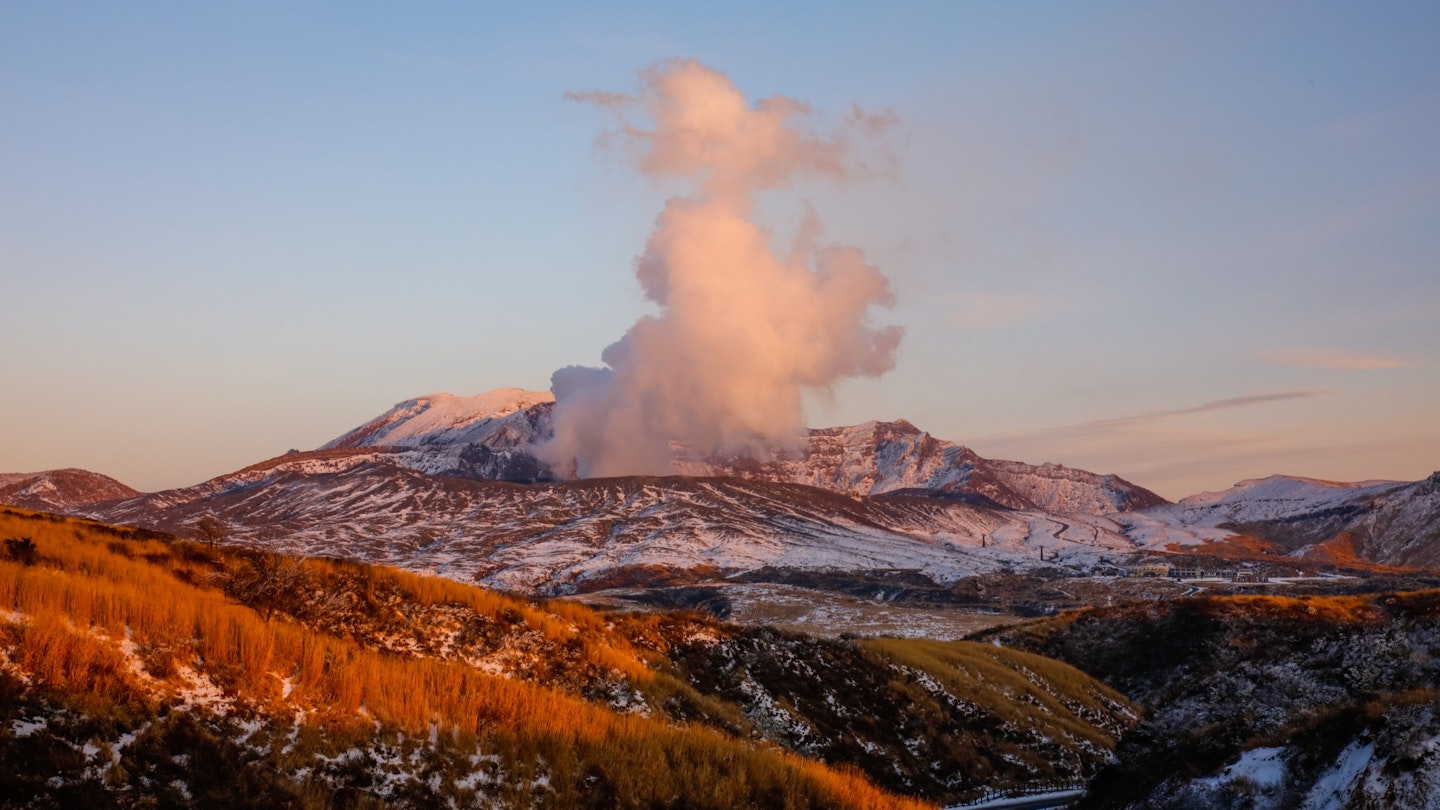Experience Mt. Aso: Japan’s Active Volcano
Mt. Aso, the name given to a collection of volcanic peaks in the center of Kyushu, the southern-most of Japan’s four main islands, is Japan’s most active volcano. It’s also one of the best places in Japan to experience the impact of fire and water on the landscape and the lives of the people who live here.
The Power of Fire
Mt. Aso and Its Caldera
Stretching 18km east-to-west and 25km north-to-south, the Mt. Aso caldera is one of the world’s largest. It resulted from the mega-eruption of several volcanoes in the center of the island of Kyushu between 270,000 and 90,000 years ago, the force of which scattered ash and rock fragments across thousands of kilometers.
The impact of ancient eruptions is still evident across Kyushu today, especially in Kumamoto Prefecture, which is home to the caldera created when the volcano collapsed in on itself due to the eruption’s force.
The Aso range remains active, with the summit often off-limits. However, the volcano’s activity is closely monitored, ensuring a safe yet close experience for visitors wishing to observe this impressive natural wonder.
From the Aso Volcano Museum, you can often witness massive clouds billowing from Mt. Aso’s Nakadake Crater, located just under three kilometers away. On most days, these clouds comprise predominantly steam generated by volcanic heat. In October 2021, a notable eruption sent gray ash clouds soaring 3.5 km into the atmosphere.
Aso UNESCO Global Geopark
Recognized for its unique geology, this area has been designated as a UNESCO Global Geopark. To fully appreciate the geology and rich ecosystems, starting your journey at the Aso Volcano Museum is highly recommended. When you are ready, a self-guided tour around the caldera offers an opportunity to see the remarkable geological features resulting from Aso’s major ancient eruptions. For those seeking more personalized exploration, trained geo-guides are available for tours.
From Daikanbo, visitors are treated to panoramic views of the caldera and volcanic peaks developed over countless years since its creation.
The Significance of Water
Impacted by the Volcano
The presence of water is integral to the story of Mt. Aso’s volcano. The caldera has been a lake at least three times in the past 90,000 years, which explains its flat terrain now covered with fields and the town of Aso.
On the caldera’s west side, a fault line has crafted a fissure from which ancient lakes drained. Here, you can find Sugaru Falls, an impressive 60-meter drop that marks the outlet for the caldera’s rivers. The name Sugaru translates to “several deer washed away,” linked to a legend involving local deities and the cultivation of rice.
This same fault line caused the significant earthquake that struck Kumamoto in April 2016, resulting in landslides and damage to infrastructure. Reconstruction efforts continue, with many roads and structures, including historic sites, being restored or rebuilt.
Waterfalls of Oguni
To the north of the caldera, expansive grasslands and the town of Oguni sit atop ancient pyroclastic flow. Two must-see waterfalls in this region are Nabegataki Falls and Shimonjo Falls, showcasing the beauty of the landscape shaped by lava flows.
Nabegataki Falls is a 20-meter-wide waterfall flowing over a 10-meter drop, with unique geological features. Visitors may find pieces of obsidian along the riverbank, remnants dating back to ancient times.
Shimonjo Falls is a narrower waterfall plunging 30 meters into a deep crevice, surrounded by impressive basalt columns formed by cooling lava. Nearby, Nabekama Falls boasts a series of rapids that have carved out peculiar potholes over time.
Relaxation at an Onsen
In the shadow of Mt. Aso, you will also find numerous onsens, or hot springs, providing rejuvenating experiences to visitors. Kurokawa, a nearby village renowned for its onsens, offers traditional inns known as ryokan. Historically, travelers would stop in this serene village to enjoy the therapeutic baths.
Many ryokan feature multiple types of baths, including riverside outdoor options and even caves. A popular activity is onsen-hopping, where visitors can buy a pass that grants access to several participating onsen baths. It’s common to see guests strolling through the village in yukata, adding to the charming atmosphere.
An overnight stay at a ryokan in Kurokawa promises delightful meals made from local ingredients and the relaxed hospitality of the staff. Flexibility is often offered to accommodate specific dietary needs with prior notice.
While onsens exist across Japan, few are set against the backdrop of an active volcano, making Mt. Aso a unique destination to appreciate the forces of nature—both fire and water—that continue to shape this remarkable island.





